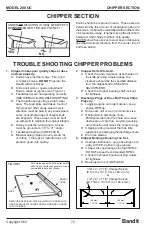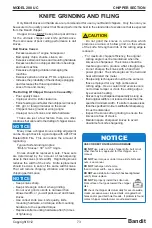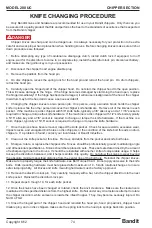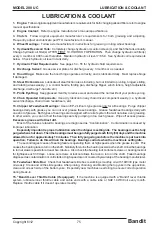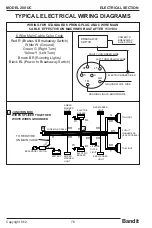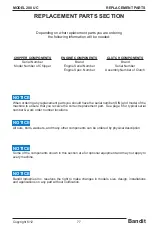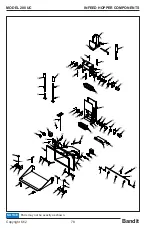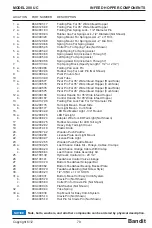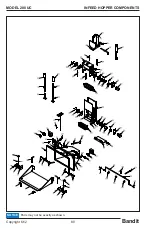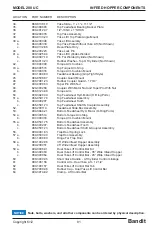
Bandit
66
Copyright 6/12
MODEL 200 UC
HYDRAULIC PUMP CHECK OUT
HYDRAULIC SECTION
HYDRAULIC PUMP CHECK WITHOUT USING A FLOW METER
To check out the hydraulic pump the mechanic will need a needle type control valve, a pressure gauge capable
of reading 3000 psi (207 bar), an in‑line 2500 psi (172 bar) relief, and a hose long enough to span between
the pump and the hydraulic tank.
1. Disconnect the pressure line going from the pump at the first component and cap the fitting at the component.
2. Attach a Tee fitting to the end of the pressure hose (which was removed from the component) and install
the Tee fitting and gauge.
3. Attach an in‑line 2500 psi (172 bar) relief to the Tee fitting with the gauge.
4. Attach the hydraulic flow control valve to the in‑line relief and the hose (you supply) to the outlet port of the
flow control valve.
5.
Make sure the pressure gauge is installed up stream from the flow control valve. Failure to do
this will cause serious damage to the hydraulic pump when testing.
6. If the hydraulic oil tank is equipped with a mesh strainer in the fill neck, remove it and place the open
end of the hose (you supply) into the tank fill neck.
7.
MAKE SURE THAT THE FLOW CONTROL VALVE IS FULLY OPEN SO AS TO ALLOW
UNRESTRICTED FLOW TO PASS THROUGH IT.
8. Start the engine to engage the pump, the clutch may have to be engaged if the pump is belt driven.
9. Have a second person lift the hydraulic hose far enough out of the tank inlet to observe the flow of oil
going into the tank. Observe the pressure gauge reading to make sure a high pressure does not exist.
10. Increase the engine speed slowly to full rpm and at the same time observe the pressure. This should
still remain low.
11.
SLOWLY
turn the needle valve on the flow control in and observe the pressure increase on the pressure
gauge.
12. Continue closing the flow control valve until the pressure gauge reading reaches 90% of the normal relief
valve setting (example: if system operates at 2500 psi (172 bar), do not exceed 2250 psi (155 bar).
Never
allow the pressure to go more than 90% of the main relief pressure.
13. If the pump is good there should be no noticeable decrease in the flow rate coming out of the hose and
into the hydraulic tank.
14. If 90% of the main relief pressure can not be obtained and/or the flow rate of the hose is considerably
less, then the pump is worn or damaged.
0
0
0
0
0
0
0
0
0
0
0
0
Do not exceed
90% of system
pressure.
First
component
after pump.
Hose
supplied by
you.
Flow
Direction
Hydraulic
Tank
Pump
Outlet
Flow
Direction
Tee
Fitting
Gauge
Flow Control
Valve
Cap after
removing
hose.
Remove any filler
neck screen.
In-Line
Relief
Summary of Contents for 200 UC
Page 17: ......
Page 35: ...Bandit 19 Copyright 6 12 MODEL 200 UC DECALS ...
Page 36: ...Bandit 20 Copyright 6 12 MODEL 200 UC DECALS ...
Page 69: ...Bandit 53 Copyright 6 12 MODEL 200 UC HYDRAULIC SECTION HYDRAULIC SECTION ...
Page 126: ...Bandit 110 Copyright 6 12 MODEL 200 UC SERVICE RECORD SERVICE RECORD DATE DESCRIPTION AMOUNT ...





















